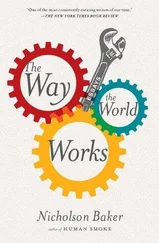Nicholson Baker - The Size of Thoughts - Essays and Other Lumber
Здесь есть возможность читать онлайн «Nicholson Baker - The Size of Thoughts - Essays and Other Lumber» весь текст электронной книги совершенно бесплатно (целиком полную версию без сокращений). В некоторых случаях можно слушать аудио, скачать через торрент в формате fb2 и присутствует краткое содержание. Год выпуска: 1997, Издательство: Vintage, Жанр: Публицистика, Критика, на английском языке. Описание произведения, (предисловие) а так же отзывы посетителей доступны на портале библиотеки ЛибКат.
- Название:The Size of Thoughts: Essays and Other Lumber
- Автор:
- Издательство:Vintage
- Жанр:
- Год:1997
- ISBN:нет данных
- Рейтинг книги:4 / 5. Голосов: 1
-
Избранное:Добавить в избранное
- Отзывы:
-
Ваша оценка:
- 80
- 1
- 2
- 3
- 4
- 5
The Size of Thoughts: Essays and Other Lumber: краткое содержание, описание и аннотация
Предлагаем к чтению аннотацию, описание, краткое содержание или предисловие (зависит от того, что написал сам автор книги «The Size of Thoughts: Essays and Other Lumber»). Если вы не нашли необходимую информацию о книге — напишите в комментариях, мы постараемся отыскать её.
The Size of Thoughts: Essays and Other Lumber — читать онлайн бесплатно полную книгу (весь текст) целиком
Ниже представлен текст книги, разбитый по страницам. Система сохранения места последней прочитанной страницы, позволяет с удобством читать онлайн бесплатно книгу «The Size of Thoughts: Essays and Other Lumber», без необходимости каждый раз заново искать на чём Вы остановились. Поставьте закладку, и сможете в любой момент перейти на страницу, на которой закончили чтение.
Интервал:
Закладка:
But if, on the other hand, Revell/Monogram were to offer a 1:48 model of the automated tape-lamination machine that Northrop designed to manufacture the composite materials that are molded into its plane, I would sit up very quickly. There is a kit I would buy and build. And now a regressive vision rises up before me — a vision of a whole Revell/Monogram “Factory Floor” series, marketed along the lines of the “Yeager Super Fighters” series, with Eli Whitney giving the thumbs-up sign on the box in place of the craggy test pilot: authentic scale replicas of great production-lines from new and mature industries around the world. The masterpiece of this urgently needed set of kits, the one that would exact an unprecedented level of artistry from the talented mold-makers in Morton Grove — who follow, incidentally, a set of milestones similar to major wedding anniversaries, from paper drawings, through overscale basswood forms (carved and sanded with Ruskinian care and thrown out once their shape has been captured in epoxy), to the final jubilee of steel molds, engraved and polished by adepts in Windsor, Canada, or in Hong Kong (where the machinists, according to one mold-layout engineer I talked to, have an especially “soft touch” with airplane likenesses) — the final masterpiece of the series would have to be a superbly detailed, vintage 1979 Cincinnati Milacron injection press, complete with warning decals, rotating screw, and a fully removable mold block ready to produce two MiG-29s a minute around the clock. When production of the toy commenced, and the real twelve-ton machine began to sigh and kick onto its conveyor belt a model of itself — in this way manufacturing not another unbuilt airplane but the unbuilt tool responsible for all unbuilt airplanes — we would be witnesses to one of the greatest moments in the Age of Plastic. And by inciting later generations of avid modelers to acknowledge the intellectual satisfactions of factory engineering early enough for any potential zealotry in that direction to take permanent hold, we might also find that in passing we had done something small but helpful toward reversing the industrial collapse of the United States.
Until this great day comes, however, we must be content to collect the airplane kits themselves, shaking them tentatively, making copies of their contents in the box, tactfully inspecting their rougher undersides, browsing their multilingual directions, and then piling them somewhere safe, unglued.
(1989)
The Projector
The finest moment in The Blob (1958) occurs in a smalltown movie theater, during a showing of something called Daughter of Horror . While the pre-McLuhanite projectionist reads his hardcover book, the Blob — a giant protean douche-bag — begins to urge its heat-seeking toxic viscosity through ten tiny slits in an air vent. Past the turning movie reel, we watch the doomed projectionist glance out the viewport at the screen, preparing for a “changeover”—an uninterrupted switch from the running projector, whose twenty-minute reel is almost over, to the second, idle one, which is all threaded and ready to roll. He senses something at his back; he turns; he gives the flume of coalesced protoplasm a level look — then it gets him. Now unattended, the first projector plays past the cue for the changeover and runs out of film. The disgruntled audience looks around and spots the Blob (in an image that must have inspired the development of the Play-Doh Fun Factory) extruding itself in triumph from all four of the little windows — two projector ports and two viewports — in the theater’s rear wall.
Chuck Russell’s remake of The Blob (1988) brings every detail, or almost every detail, of the first film neatly up to date. The movie-within-a-movie is now entitled Garden Tool Massacre . “Isn’t it awfully late to be trimming the hedges?” a camp counselor mutters while making out with his girlfriend, having noticed a masked stranger at work on the shrubbery after dark. “Wait a minute,” he then says, suspicions aroused. “Hockey season ended months ago.” Cut to the booth, where “Hobbs,” the bored projectionist (whose life will indeed prove to be “solitary, poor, nasty, brutish, and short”), his head again seen past a turning reel of film, reads a magazine and fiddles left-handedly with a yo-yo. The second-generation Blob, far peppier and more enterprising than its forebear, pukes its way briskly up the air-conditioning duct and plasters the unhappy Hobbs to the ceiling. Moments later, the manager, looking up, discovers his colleague, a Ralph Steadman grimace on his face, half consumed in an agony of Handi-Wrap and dyed cornstarch, the yo-yo still rising and falling from his twitching finger.
Why the addition of the yo-yo? the student of film technology may wonder. Is it merely a gratuitous prop, or does it tell us something? I suspect that the yo-yo is a reference to the classical principle of the movie reel, which repeatedly rewinds and relinquishes its length of film. The reason Mr. Russell had the iconography of the movie reel very much on his mind in shooting this scene, I think, is that, despite all his diligent updating of cultural references, and despite the elaborate verisimilitude of the movie’s gruesomeness, he was not quite able to bring himself to reveal to us the reality of modern theatrical-movie projection. For the terrifying reality is that film is no longer projected from reels .
Film is projected from platters. The platter system (Fig. 1), first invented by a German projectionist, Willie Burth, and perfected by Norelco, in the Netherlands, about twenty years ago, works this way: The film arrives from the distributor on five or six reels in an octagonal steel suitcase. The projectionist splices the film from these reels together, winding it in one big spiral onto one of (typically) three horizontal circular steel disks, each roughly four feet in diameter. When the projectionist wants to set up a show, he pulls the beginning of the film from the middle of the platter, threads it through the platter’s central “brain” (its lumpily massed rollers look somewhat cerebral), thence around a few guide rollers screwed into the wall or the ceiling, and loads it into the sprockets of the projector. After it passes through the “gate” (where it is actually projected), the film usually travels through the sound head (where a light reads the optical soundtrack), loops around several more guide rollers, and ends up being wound in another huge spiral on one of the other horizontal platters. Because the film leaves from the middle of the platter, instead of the outside, rewinding between shows, reel by reel, is no longer necessary. And each theater needs only one projector per screen, rather than the traditional tag-team alternating two.

Fig. 1. On the top platter (1) film unfurls from the inside out, and winds up on the middle platter (2). The lowest platter (3) is a spare, used for a second feature. The canted console (4), containing the xenon lamphouse and sound equipment, aims the image from the projector (5) through the glass projector port (6), and onto the screen. In the soundhead (7), a solar cell interprets the soundtrack. The projectionist keeps an eye on image quality through the viewport (8) .
There are a few revival houses in Los Angeles and New York that continue to show films on two projectors from reels, but the vast majority of the country’s theaters — art houses and mall-plexes alike — currently employ the platter system, and have for the past decade. Yet of the projector-movies from this period that I have seen (movies that include a moment or two in a contemporary projection booth, I mean), not one — not Chuck Russell’s Blob or Joe Dante’s Gremlins (1984: gremlins invade theater and play Reel 4 of Snow White ), or Night of the Comet (1984: couple spend night in steel-firewalled projection booth and escape being turned into red dust or killer maniacs by comet), not Susan Seidelman’s wonderful Desperately Seeking Susan (1985: we’ll get to this one later) or Gas, Food, Lodging (1992: girl falls for Chicano projectionist) — dares give us a glimpse of a turning platter. I was sure, having read a description (in Carol J. Clover’s thoughtful book Men, Women, and Chain Saws: Gender in the Modern Horror Film ) of a despicable Italian zombie movie called Demons (1985), that, because its action — fountains of pus and helicopter-blade disembowelings — is set within a fully automated and (of course) transcendently evil movie theater, with an unmanned projection booth, and because the second-largest manufacturer of movie projectors in the world happens to be Milan’s Cinemeccanica, that at least here, in this admittedly unsavory setting, we would be shown something approaching the technical truth about movie projection. But no: although the demonic equipment blinks with a few more lights than usual, it is fitted with the familiar pairs of reels up front.
Читать дальшеИнтервал:
Закладка:
Похожие книги на «The Size of Thoughts: Essays and Other Lumber»
Представляем Вашему вниманию похожие книги на «The Size of Thoughts: Essays and Other Lumber» списком для выбора. Мы отобрали схожую по названию и смыслу литературу в надежде предоставить читателям больше вариантов отыскать новые, интересные, ещё непрочитанные произведения.
Обсуждение, отзывы о книге «The Size of Thoughts: Essays and Other Lumber» и просто собственные мнения читателей. Оставьте ваши комментарии, напишите, что Вы думаете о произведении, его смысле или главных героях. Укажите что конкретно понравилось, а что нет, и почему Вы так считаете.












